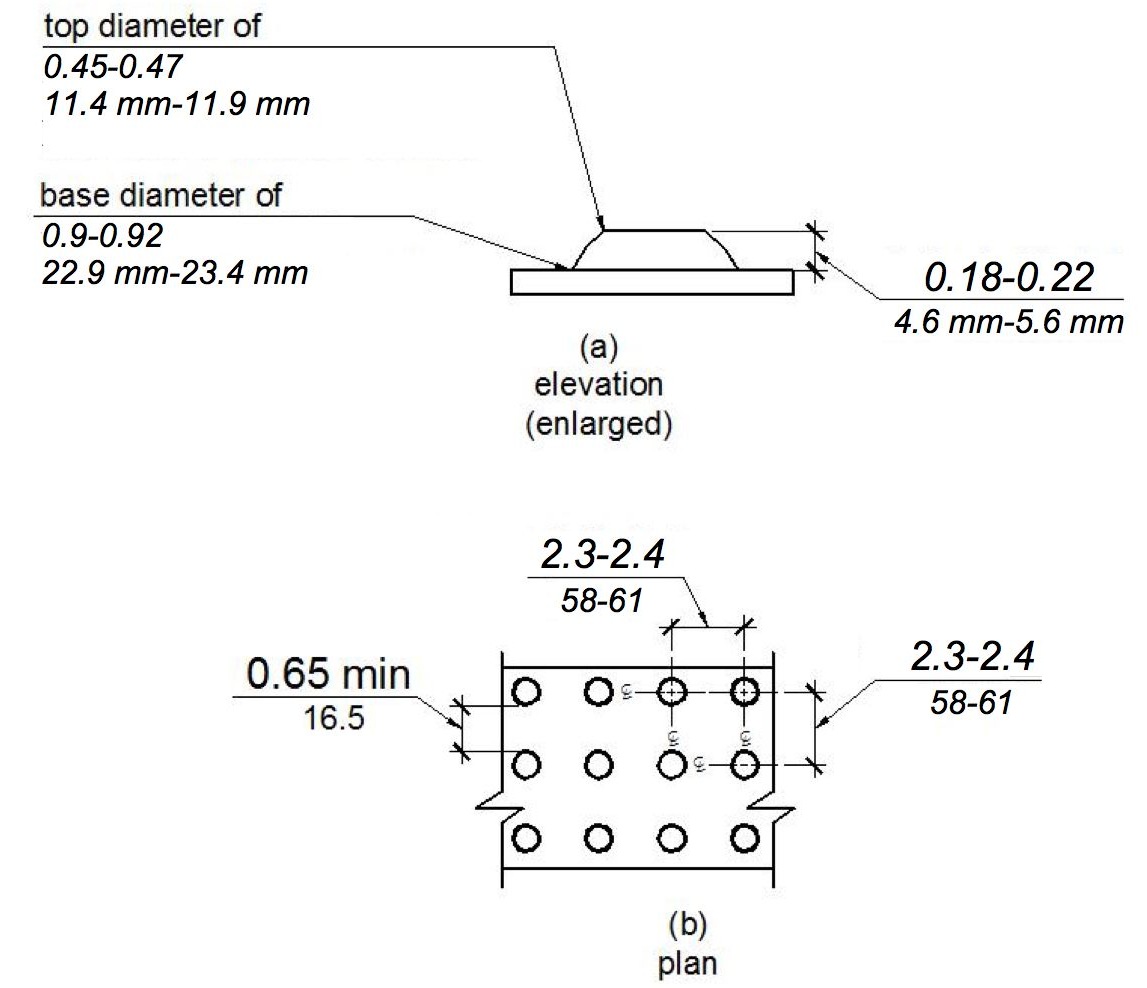2013 California Standards for Accessible Design Pocket Guide
11B-705.1 Detectable warnings
11B-705.1.1 General.
Detectable warnings shall consist of a surface of truncated domes and shall comply with Section 11B-705.
11B-705.1.1.1 Dome size.
Truncated domes in a detectable warning surface shall have a base diameter of 0.9 inch (22.9 mm) minimum and 0.92 inch (23.4 mm) maximum, a top diameter of 0.45 inch (11.4 mm) minimum and 0.47 inch (11.9 mm) maximum, and a height of 0.18 inch (4.6 mm) minimum and 0.22 inch (5.6 mm) maximum.
[2010 ADAS] 705.1.1 Dome Size. Truncated domes in a detectable warning surface shall have a base diameter of 0.9 inch (23 mm) minimum and 1.4 inches (36 mm) maximum, a top diameter of 50 percent of the base diameter minimum to 65 percent of the base diameter maximum, and a height of 0.2 inch (5.1 mm).
11B-705.1.1.2 Dome spacing.
Truncated domes in a detectable warning surface shall have a center-to-center spacing of 2.3 inches (58 mm) minimum and 2.4 inches (61 mm) maximum, and a base-to-base spacing of 0.65 inch (16.5 mm) minimum, measured between the most adjacent domes on a square grid.
[2010 ADAS] 705.1.2 Dome Spacing. Truncated domes in a detectable warning surface shall have a center-to-center spacing of 1.6 inches (41 mm) minimum and 2.4 inches (61 mm) maximum, and a base-to-base spacing of 0.65 inch (17 mm) minimum, measured between the most adjacent domes on a square grid.
Exception: Where installed in a radial pattern, truncated domes shall have a center-to-center spacing of 1.6 inches (41 mm) minimum to 2.4 inches (61 mm) maximum.

FIGURE 11B-705.1 ‡‡
SIZE AND SPACING OF TRUNCATED DOMES
11B-705.1.1.3 Color and Contrast.
Detectable warning surfaces at transit boarding platform edges, bus stops, hazardous vehicular areas, reflecting pools, and track crossings shall comply with Section 11B-705.1.1.3.1. Detectable warnings at other locations shall comply with either Section 11B-705.1.1.3.1 or Section 11B-705.1.1.3.2. The material used to provide visual contrast shall be an integral part of the surface.
[2010 ADAS] 705.1.3 Contrast. Detectable warning surfaces shall contrast visually with adjacent walking surfaces either light-on-dark, or dark-on-light.
Exception: Where the detectable warning surface does not provide a 70 percent minimum contrast with adjacent walking surfaces, a 1 inch (25 mm) wide minimum visually contrasting surface shall separate the detectable warning from adjacent walking surfaces. The visually contrasting surface shall contrast with both the detectable warning and adjacent walking surfaces either light-on-dark, or dark-on-light.
11B-705.1.1.3.1.
Detectable warning surfaces shall be yellow and approximate FS 33538 of Federal Standard 595C.
11B-705.1.1.3.2.
Detectable warning surfaces shall provide a 70 percent minimum visual contrast with adjacent walking surfaces. Contrast in percent shall be determined by:
Contrast percent = [(B1-B2)/B1] x 100 percent where
B1 = light reflectance value (LRV) of the lighter area and
B2 = light reflectance value (LRV) of the darker area.
11B-705.1.1.4 Resiliency.
Detectable warning surfaces shall differ from adjoining surfaces in resiliency or sound-on-cane contact.
Exception: Detectable warning surfaces at curb ramps, islands or cut-through medians shall not be required to comply with Section 11B-705.1.1.4.
11B-705.1.2 Locations.
Detectable warnings at the following locations shall comply with Section 11B-705.1.
11B-705.1.2.1 Platform edges.
Detectable warning surfaces at platform boarding edges shall be 24 inches (610 mm) wide and shall extend the full length of the public use areas of the platform.
11B-705.1.2.2 Curb ramps.
Detectable warnings at curb ramps shall extend 36 inches (914 mm) in the direction of travel. Detectable warnings shall extend the full width of the ramp run less 2 inches (51 mm) maximum on each side, excluding any flared sides. Detectable warnings shall be located so the edge nearest the curb is 6 inches (152 mm) minimum and 8 inches (203 mm) maximum from the line at the face of the curb marking the transition between the curb and the gutter, street or highway.
Exception: On parallel curb ramps, detectable warnings shall be placed on the turning space at the flush transition between the street and sidewalk. Detectable warnings shall extend the full width of the turning space at the flush transition between the street and the sidewalk less 2 inches (51 mm) maximum on each side.
11B-705.1.2.3 Islands or cut-through medians.
Detectable warnings at pedestrian islands or cut-through medians shall be 36 inches (914 mm) minimum in depth extending the full width of the pedestrian path or cut-through less 2 inches (51 mm) maximum on each side, placed at the edges of the pedestrian island or cut-through median, and shall be separated by 24 inches (610 mm) minimum of walking surface without detectable warnings.
Exception: Detectable warnings shall be 24 inches (610 mm) minimum in depth at pedestrian islands or cut-through medians that are less than 96 inches (2438 mm) in length in the direction of pedestrian travel.
11B-705.1.2.4 Bus stops.
When detectable warnings are provided at bus stop boarding and alighting areas, the detectable warnings shall extend the full width of the boarding/alighting area and shall be 36 inches (914 mm) minimum in depth.
11B-705.1.2.5 Hazardous vehicular areas.
Detectable warnings at hazardous vehicular areas shall be 36 inches (914 mm) in width.
11B-705.1.2.6 Reflecting pools .
When detectable warnings are provided at reflecting pools, it shall be 24 inches (610 mm) minimum and 36 inches (914 mm) maximum in width.
11B-705.1.2.7 Track crossings.
Detectable warnings at track crossings shall be 36 inches (914 mm) in the direction of pedestrian travel and extend the full width of the circulation path.

User Comments/Questions
Add Comment/Question